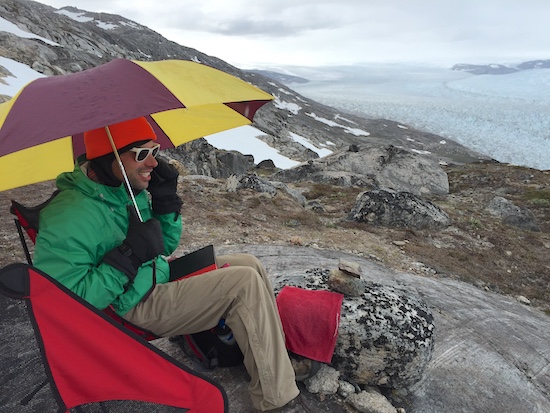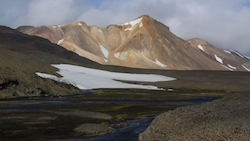SEJournal Online is the digital news magazine of the Society of Environmental Journalists. Learn more about SEJournal Online, including submission, subscription and advertising information.
 |
| Ari Daniel talking via satellite phone with Marco Werman, the host of PRI's "The World," for an interview segment about his reporting in Greenland. |
Inside Story: Reporting Science, Side-by-Side with the Scientists
Judges awarding reporter Ari Daniel and editor Peter Thomson the gold audio award in the 2016 American Association for the Advancement of Science Kavli Science Journalism Awards praised the duo for taking listeners of “The World” radio program on a gripping trip to the frontiers of climate change field research in Greenland and Iceland. “Inside Story” spoke with the pair about their multi-part series, funded in part by the Pulitzer Center for Crisis Reporting.
SEJournal Online: You explained some pretty dense science using clear explanations, analogies and evocative imagery tools: What worked best and why?
Ari Daniel: Peter suggested that instead of doing one story about glaciologist Gordon Hamilton’s work on the glacier and one story about oceanographer Fiamma Straneo’s work in the fjord, we should feature both of them across two stories — one focusing on the big picture and one zooming in on the new methods they were both using. That was supremely helpful when I was in the field.
The decision to make the piece into a detective story helped structure the characters and flow as well. In addition, my surroundings were so foreign that they inspired analogy and metaphor while I was in the field: When I saw the Icelandic landscape scrolling past my window from inside the field team’s car, the peaks looked like confections made of butterscotch and dark chocolate.
SEJournal Online: The volcano story in particular felt very new — how did you learn about it and execute a story that involves something that may only possibly occur?
Peter Thomson: I’d read several years back about a handful of scientists warning about the geological impacts of climate change. (Ultimately) I became convinced they were legit and really on to something. Not long afterwards, Icelandic scientists began issuing warnings about a possible eruption of the Bárðarbunga volcano, the country’s biggest, which also happens to lie under a glacier.
The volcano never blew, but in reading up on the story I came across something about the dangers of such volcanoes possibly becoming more active as the overlying glaciers melt. That was the “aha” moment. Pretty much all anyone could say for sure was that the glaciers were melting, but even the scientists studying them couldn’t (positively) say how that would affect the volcanoes. So assessing and incorporating that uncertainty had to be a big part of the story.
'Give us the context, the frame, the why along with the what.'
— Editor Peter Thomson on
reporting the scientific process
SEJournal Online: What was the coolest thing you reported on that didn’t make it into the pieces? Why?
Daniel: My experience actually walking on the glacier. It was spellbinding — I couldn’t believe that a place of such extreme majesty exists on our planet. I recorded the crunching of the ice under my feet and the flow of water deep down inside a crevasse.
At one point, one of the scientists held up his thermos and asked if I wanted to drink the glacier. He’d gathered water from a small pool on the surface. I drank, and it was nothing and everything at once. Nothing because there was no taste and everything because I had a morsel of actual melted glacier in my mouth, crisp and chill. I recorded the whole thing, but unfortunately, it didn’t make it to air.
Reporter, editor, working as partners
SEJournal Online: How did the partnership between editor and reporter work on a series like this?
Daniel: I approached Peter about the possibility of a trip to Greenland after I’d been in touch with Straneo about accompanying her and her team on her research cruise. We both started looking into additional stories I could cover at that point.
Because internet access was patchy in the field, Peter and I discussed the best way for me to cover the stories in advance. We met when I returned to talk about the structure of the stories again now that I had actual tape in hand. I wrote up drafts of all the stories, and then Peter and I tossed them back and forth until we converged on the final scripts.
Thomson: We talked regularly about focus, reporting and storytelling strategies, first as the project took shape, then while Ari was in the field, and then again after he got back. The stories then went through probably half a dozen or more drafts over several months. I’d offer feedback on general themes or specific sections or passages and Ari would rewrite with that in mind, or I’d do some heavy reworking and rewriting myself and send that back to Ari for his comment.
Sometimes we’d meet and talk in person, other times just communicate by email. It was a flexible and fluid process, but as I said, very collaborative. Ultimately, after we settled on near-final scripts for each one I’d mix them, we’d listen, and then go back in for some further tweaking.
 |
| Mountains surge skyward in Iceland. Photo: Ari Daniel |
SEJournal Online: What was the biggest challenge of this project?
Daniel: For me, the biggest challenge of this project came nearly a year after the reporting trip. I received an email that Gordon Hamilton had passed away the day before in a field accident in Antarctica when his snowmobile plunged into a deep glacial crevasse. I had only spent a week with Gordon, but I had become quite fond of the man and we had stayed in touch. He was a teacher, a mentor and a friend — and he was also a husband and a father.
Thomson: Overall, the Greenland part of the project was among the most challenging I’ve had to edit in a long time, but in all the best ways. The science was very complex — incredibly detailed while also broad in scope and sweeping in its impact. We had to be sure we got it right, but present it in a way that was understandable for a lay audience and worked on the radio, a medium in which the listener can’t go back and re-read a section to make sure they got it.
‘Get into the field’
SEJournal Online: Any advice for journalists who want to write about the process of science as much as the science itself?
Daniel: For me, joining scientists in the field is an ideal way to do a radio story. There’s all the science I want, alongside the elements that make for a lively and immersive narrative: character, drama, dialogue, scene and sound. It’s also a good way to tell a story about the process of science since it’s unfolding in all its imperfect glory while you’re there.
Thomson: Get out into the field and the lab. Find the people and the passion behind the process. Roll the story out like a mystery. Tell us how they think of the problem and how they’re approaching it. Explore any novel or creative means they’re using, or tell us if they’re falling back on old, low-tech, long-forgotten, tried-and-true approaches. Give us the context, the frame, the why along with the what. Use metaphor, analogy, etc. to help explain obscure concepts and difficult ideas.
SEJournal Online: What are you both working on next?
Daniel: I work as a digital producer at NOVA and in the coming year, I’ll be working within a team to create a series of quick turnaround video, radio and social media stories in response to current events and the news cycle.
In addition, I’m producing the second installment of a live show I’ve developed at the Charles Hayden Planetarium [at the Museum of Science in Boston] called “Stories under the Stars.” It’s a mash-up of live storytelling, radio and music that unfurls amidst immersive visuals projected on the dome. And I’ve got at least one international reporting trip in the works, so I’m busy hunting down radio story possibilities there.
Thomson: These days the environment desk at “The World” is focusing a lot of its attention on people, institutions and communities that are responding to and trying to come up with solutions to the zillion aspects of the climate crisis and other environmental challenges. In particular we’re focusing a lot on stories related to energy, agriculture, resilience, emerging climate science and the growing real-world impacts of the climate crisis — always grounded, of course, in real people, with real stories, in real places.
Daniel, a Ph.D in biological oceanography, has been reporting on science for nine years. His pieces, which have taken him to five continents, have been showcased in numerous outlets, including public radio programs “Here & Now,” “All Things Considered” and “Marketplace.” Daniel also co-produces the Boston branch of “Story Collider,” a live storytelling show about science.
Thomson, a member of the SEJ Board of Directors, has been covering the environment for more than 20 years and signed on as environment editor for “The World” in 2008. An award-winning reporter, he was the founding editor and producer of “Living on Earth” in 1991. He is also the author of “Sacred Sea: A Journey to Lake Baikal,” about the world's largest and deepest lake.
“Inside Story” editor Beth Daley was recently named director of strategic development at InsideClimate News. Previously, she had been a reporter and director of partnerships at the New England Center for Investigative Reporting, a nonprofit newsroom based at Boston University and affiliated with WGBH News.
* From the weekly news magazine SEJournal Online, Vol. 2, No. 9. Content from each new issue of SEJournal Online is available to the public via the SEJournal Online main page. Subscribe to the e-newsletter here. And see past issues of the SEJournal archived here.












 Advertisement
Advertisement 



